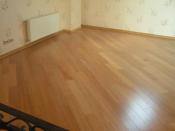Search
Login
Garage of foam blocks with your own hands on a personal plot
The construction of the garage is very important, because it should serve as a reliable shelter for cars. Common wall materials used in its construction: cinder blocks, bricks, gas and foam concrete blocks. If we consider in detail all their positive aspects and shortcomings, then foam concrete will receive a definite advantage, the material is relatively cheap, light, warm. A car owner who does not have special knowledge in the field of construction crafts will be able to build a garage from foam blocks with his own hands. Of course, if such a serious construction will be carried out for the first time, it is advisable to first familiarize yourself with all the stages and rules of the work.
Content
- We build a garage of foam blocks - the pros and cons of material
- What should be considered when designing a garage, we calculate the material
- We make markings on the ground
- We are building the foundation for a foam block garage
- How to install a gate
- We build a garage from foam blocks - walling video
- How to build a roof video
- Garage insulation
- Floor construction video
- Manhole
We build a garage of foam blocks - the pros and cons of material

Among the main advantages of foam blocks it should be noted:
- affordable cost
- low weight, which allows to obtain considerable savings on the construction of the foundation,
- high strength of the erected structure, long period of operation
- due to the low thermal conductivity of the material, it is possible to do without additional thermal insulation of the walls
- simplicity and ease of installation will allow you to perform work in a short time
- attraction of heavy construction equipment is not required.
Among the disadvantages of the material should be noted its impermeability to vapors, i.e. perhaps the garage will have to be equipped not only with conventional ventilation hatches located at different heights, but also with forced-air and exhaust ventilation, powered by an electric drive. This fact may present some inconvenience to the owner during the operation of the facility. Although foam concrete is not prone to fire, in case of a serious fire under the influence of high temperatures, foam concrete can burn, emitting toxic gases.
Since the advantages of the material significantly exceed the significance of its disadvantages, consider the issue as build a garage of foam blocks still makes sense.
What should be considered when designing a garage, we calculate the material

The first thing is to develop a project. Depending on the location of the site, the structure of the soil and the proximity of the occurrence of groundwater, the type of foundation and the design option for the structure are selected. If you have the skills to perform simple calculations, you can do the drawing yourself or use special programs that are easy to find on the Internet. For example - the ArchiCad program will help to develop drawings, find out how many foam blocks are needed for the garage, the program will need to set the desired wall thickness and dimensions of the foam block. Independent execution of calculations will allow the introduction of all the necessary nuances into the project.

Even before the start of design work, the issue of the functionality of the garage should be resolved:
- will you need a viewing hole
- will there be a basement for vegetables and conservation,
- there is an option of equipping part of the room with shelves and diverting it to the pantry for inventory or for the work area.

The mentioned points will affect the dimensions of the structure, the type of its foundation. You can also apply ready-made garage designs from foam blocks, of course, if they provide for all the requirements of car owners.
We make markings on the ground
The marking of the site is performed with wooden pegs and a nylon cord. Be sure to make sure that the angle between the lines that beat the walls is 90 degrees. All lines that are present in the drawings are transferred to the terrain.
Having marked all the lines, it is advisable to stand on the side where the gates will be and analyze whether other structures, bushes or fences will interfere with their opening. After making sure that everything is fine, you can begin excavation work.
We are building the foundation for a foam block garage

The small proportion of foam blocks allows you to abandon the construction capital foundation, but the weight of the wall material is not the only indicator that is taken into account when designing - the type of soil and the properties that are inherent in it are no less important. When groundwater occurs at a depth of 2 - 2.5 m, while the soil does not belong to the category of heaving, the depth foundation You can plan about 0.5 m.

In conditions of heaving soil best foundation option - concrete monolith. It will warn you when bending loads will affect the walls. From such loads, the foam blocks crack and subsequently collapse. So that the walls do not crack when the soil moves, they are installed on a monolithic slab floating in the ground with the garage.
If the construction of a basement or an inspection pit is planned, then it is impossible to plan the construction of a monolithic slab - you will need to make a combined pile-tape foundation or a recessed tape.
For the construction of a strip foundation, you will need:
- dig a trench with a depth of 0.7-0.8 m, and a width equal to the width of one foam block plus 0.15 m
- pour a layer of sand 0.15 m, ram it
- pour a layer of crushed stone of 0.1 m, compact it
- install formwork
- assemble the frame from the fittings and insert into the trench
- prepare concrete and pour it in one step.

To continue working, you will have to wait until the concrete has completely hardened. Next, the foundation is waterproofed along the entire perimeter. This will prevent the penetration of capillary moisture into the wall materials. As a waterproofing agent, you can use roofing material in 2 or 3 addition.
How to install a gate

Garage doors should be installed before the start of the construction of walls - during the laying process, they are built into the walls. Metal rods 0.4 m long and 12 mm thick should be welded to the frame into which the gates will be installed, 4 pieces on each side. They should be positioned so that each of them is at the junction of the foam blocks.

Gates should be primed and painted before installation. If the garage is designed to store 1 car, then the width of the gate should be about 3 m.

When installing the gate in the opening, you must strictly observe the vertical line, controlling the plumb line and level.

For bracing use wooden braces, they are installed on both sides.
We build a garage from foam blocks - walling

They begin to build walls from the corners. The wall thickness should be about 20 cm, respectively, blocks are selected with a thickness of 20 cm, so that they are installed in a row along the wall. With such an arrangement of foam blocks, material and time savings are achieved.
The cost of the walls of the foam block depends on the brand of material, its size, method of masonry. For example, to simplify the process, you should purchase corner blocks - in this case, you will not have to verify the correctness of the corner laying.

Masonry is performed on cement-sand mortar or on special glue. Although the cost of glue is higher, you should focus on its use - the heat-insulating qualities of the walls will be much higher, the use of glue allows you to bring the thickness of the seam to 2-3 mm, compared with 10 mm when using cement mortar.
After mounting the corners between them, the cord is pulled, and the wall is laid on it. The laying of corners and walls should be alternated. Masonry reinforcement should be performed with a special mesh every two rows of foam blocks. Bars welded to the gate frame are also embedded in the masonry between the blocks.
Particular attention should be paid to the correct installation of the bridge over the gate and the laying of the part of the wall located above it. For the lintel, a frame corresponding to the dimensions of the gate is welded from a corner (50 mm). It is installed from the inside of the wall, right up to the foam blocks and fixed to the solution. A piece of an I-beam, the length of which exceeds the width of the frame by at least 0.2 m on each side, is installed on top of the frame and gate. The extra length of the beam should go into the masonry of the wall. A section of the wall above the beam is performed by laying masonry blocks.
The type of roof will also influence the cost of the garage. The cheapest option is a single slope. In this case, the walls are made with a slope towards the back wall, on each meter it is necessary to reduce the height of the structure by 5 cm. There will be no particular difficulty with the arrangement of the ramp - foam blocks can be cut very easily, you can use a saw for this.

When arranging a gable roof, you will have to think through what material its back and front walls will be sewn up. To do this, you can use a wooden board or foam blocks.
How to build a roof

The concrete slabs traditionally used for the construction of the garage roof, covered with a layer of roofing material, will turn out to be unsuitable in our case - the material used to erect the walls is too light. For the construction of a single-pitched roof on the garage from foam blocks, I-beams will be required, and their length should exceed the width of the walls of the garage by about a quarter meter. Beams should be laid at a distance of 0.8 m from each other. We close the beams into the walls. On the beams (their lower shelves) we lay out sections of the 40 mm board, they should be laid denser. On top of the boards we cover a layer of roofing material, bend the edges upwards, by 0.1 m. Then we fill up the roofing material with a layer of insulation, for example, slag or expanded clay.
We take into account that along the perimeter the roof should protrude about 0.2 m beyond the boundaries of the walls - in this case, raindrops will not fall on their surface. On top of the insulation we perform a concrete screed 2-3 cm thick, after the concrete has completely solidified, we process it with a primer. As a waterproofing, you can use roofing material or bitumen mastic.

Laying of roofing material begins from the bottom of the roof, in the transverse direction, with an overlap. A properly formed roof surface will allow water to flow without stopping quietly down. For convenience, a visor can be built above the gate. It is easier to buy ready-made - a wide variety of inexpensive product designs are widely represented on the building materials market.
Garage insulation
If you wish, you can perform additional heat and sound insulation of the walls of the structure, the best option would be a three-layer system consisting of layers of foam, fiberglass, a polyethylene layer and a finishing layer, which can be used as drywall. Further walls should be plastered.
Floor construction

The construction of walls on a strip foundation involves the arrangement of floor indoors. The best option is concrete pouring.
First, backfill:
- 0.15 m of crushed stone
- 0.1 m of clean river sand
- 0.1 m gravel.
Sprayed materials should be well compacted. A concrete screed with a thickness of about 0.2 m is made on the prepared surface.
Manhole

If the construction of a viewing hole is planned in the garage, then a pit dug for it of appropriate size is first waterproofed with roofing material or modern materials, such as a special Technonikol tape. Waterproofing is mounted on the bottom and walls of the pit - to prevent deformation of the surface of the walls of the pit by groundwater during the spring flood. After installing the waterproofing, you can proceed with the installation of concrete formwork. After the solidification of concrete during the week, the formwork is removed. But concrete will receive strength properties only after 2-3 weeks.
When calculating the cost of building a garage from foam blocks, it should be noted that about 30% of the total cost of the structure is spent on the purchase of wall materials. The bulk of the money goes to the construction of the foundation and floor, roof and the purchase of related materials.





